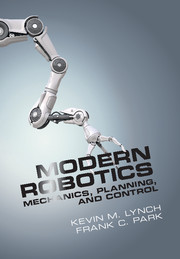Book contents
- Frontmatter
- Contents
- Foreword by Roger Brockett
- Foreword by Matthew Mason
- Preface
- 1 Preview
- 2 Configuration Space
- 3 Rigid-Body Motions
- 4 Forward Kinematics
- 5 Velocity Kinematics and Statics
- 6 Inverse Kinematics
- 7 Kinematics of Closed Chains
- 8 Dynamics of Open Chains
- 9 Trajectory Generation
- 10 Motion Planning
- 11 Robot Control
- 12 Grasping and Manipulation
- 13 Wheeled Mobile Robots
- A Summary of Useful Formulas
- B Other Representations of Rotations
- C Denavit–Hartenberg Parameters
- D Optimization and Lagrange Multipliers
- Bibliography
- Index
4 - Forward Kinematics
Published online by Cambridge University Press: 04 June 2024
- Frontmatter
- Contents
- Foreword by Roger Brockett
- Foreword by Matthew Mason
- Preface
- 1 Preview
- 2 Configuration Space
- 3 Rigid-Body Motions
- 4 Forward Kinematics
- 5 Velocity Kinematics and Statics
- 6 Inverse Kinematics
- 7 Kinematics of Closed Chains
- 8 Dynamics of Open Chains
- 9 Trajectory Generation
- 10 Motion Planning
- 11 Robot Control
- 12 Grasping and Manipulation
- 13 Wheeled Mobile Robots
- A Summary of Useful Formulas
- B Other Representations of Rotations
- C Denavit–Hartenberg Parameters
- D Optimization and Lagrange Multipliers
- Bibliography
- Index
Summary
The forward kinematics of a robot refers to the calculation of the position and orientation of its end-effector frame from its joint coordinates θ. Figure 4.1 illustrates the forward kinematics problem for a 3R planar open chain. The link lengths are L1, L2, and L3. Choose a fixed frame ﹛0﹜ with origin located at the base joint as shown, and assume an end-effector frame ﹛4﹜ has been attached to the tip of the third link. The Cartesian position (x, y) and orientation ϕ of the end-effector frame as functions of the joint angles (θ1, θ2, θ3) are then given by
If one is only interested in the (x, y) position of the end-effector, the robot's task space is then taken to be the x–y-plane, and the forward kinematics would consist of Equations (4.1) and (4.2) only. If the end-effector's position and orientation both matter, the forward kinematics would consist of the three equations (4.1)– (4.3).
While the above analysis can be done using only basic trigonometry, it is not difficult to imagine that for more general spatial chains the analysis can become considerably more complicated. A more systematic method of deriving the forward kinematics might involve attaching reference frames to each link; in Figure 4.1 the three link reference frames are respectively labeled ﹛1﹜, ﹛2﹜, and ﹛3﹜. The forward kinematics can then be written as a product of four homogeneous transformation matrices:
Observe that T34 is constant and that each remaining Ti−1,i depends only on the joint variable θi.
As an alternative to this approach, let us define M to be the position and orientation of frame ﹛4﹜ when all joint angles are set to zero (the “home” or “zero” position of the robot). Then
Now consider each revolute joint axis to be a zero-pitch screw axis. If θ1 and θ2 are held at their zero position then the screw axis corresponding to rotating about joint 3 can be expressed in the ﹛0﹜ frame as
You should be able to confirm this by simple visual inspection of Figure 4.1. When the arm is stretched out straight to the right at its zero configuration, imagine a turntable rotating with an angular velocity of ω3 = 1 rad/s about the axis of joint 3.
- Type
- Chapter
- Information
- Modern RoboticsMechanics, Planning, and Control, pp. 116 - 145Publisher: Cambridge University PressPrint publication year: 2017



